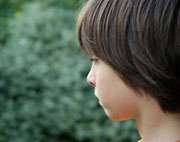Spacing between sibling births tied to autism risk in study

(HealthDay)—Children conceived either less than one year or more than five years after the birth of a sibling could be at increased risk for autism, a new study suggests.
However, both the study's lead author and an outside expert agree that the research can't prove that birth spacing has any causative role in autism.
"Most importantly, it is important that parents understand that the odds for autism are still extremely low, even when pregnancies are close together or far apart," said outside expert Dr. Andrew Adesman. He is chief of developmental and behavioral pediatrics at Cohen Children's Medical Center of New York, in New Hyde Park, N.Y.
In the study, researchers analyzed data from more than 7,300 children born in Finland between 1987 and 2005. About one-third of the youngsters had been diagnosed with autism.
Compared to children conceived two to five years after the birth of a sibling, the risk of autism was 50 percent higher among those conceived less than a year after, nearly 30 percent higher among those conceived five to 10 years after, and 40 percent higher among those conceived more than 10 years after.
The study was published recently in the Journal of the American Academy of Child and Adolescent Psychiatry.
"It was intriguing to see that the risk of ASD [autism spectrum disorder] diagnosis was higher in both closely and distantly spaced pregnancies," study leader Keely Cheslack-Postava, of Columbia University in New York City, said in a journal news release.
However, she stressed, "it is important to realize that we can't say from this study that spacing of pregnancies per se is a cause of ASD—this is most likely a proxy of other factors that are more directly related to the chance of the child's developing ASD."
Adesman agreed. "Although having a very short or very long interval between consecutive pregnancies may put the second child at some increased risk for an autism spectrum disorder, it is unclear why this is the case," he said.
"As researchers examine obstetric and environmental factors among children with an autism spectrum disorder, more and more apparent risk factors are identified," Adesman said.
"Although studies like this will likely lead to a greater understanding of the many factors that seem to be associated with ASDs, I can imagine women becoming more and more anxious or overwhelmed when it comes to minimizing their risk for a child with ASD," he added.
According to Cheslack-Postava, the real value of the finding lies in its potential relevance to autism research, not in any guideline as to when couples should have children.
"The importance of this finding lies in the clues that it can provide in terms of understanding how the prenatal environment is related to outcomes after birth," she explained.
More information: The U.S. National Institute of Neurological Disorders and Stroke has more about autism.
Copyright © 2014 HealthDay. All rights reserved.















